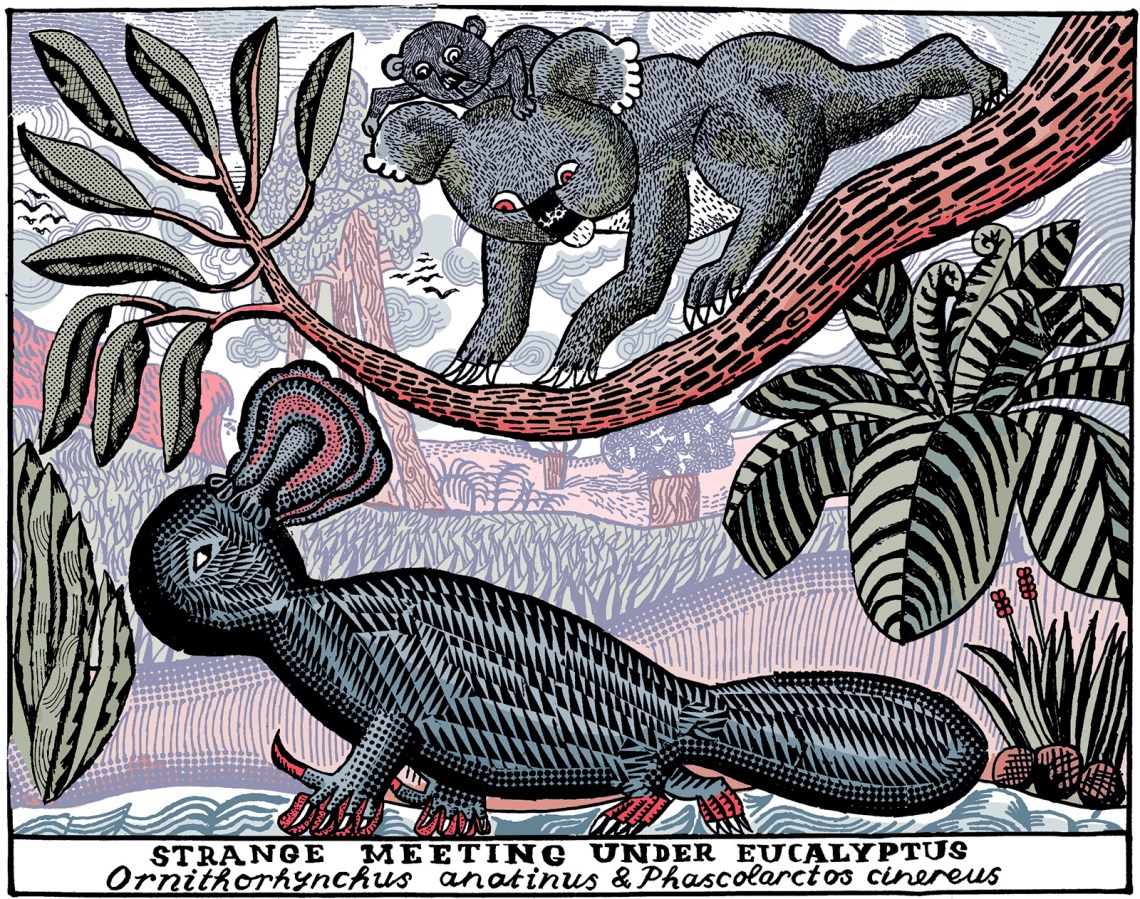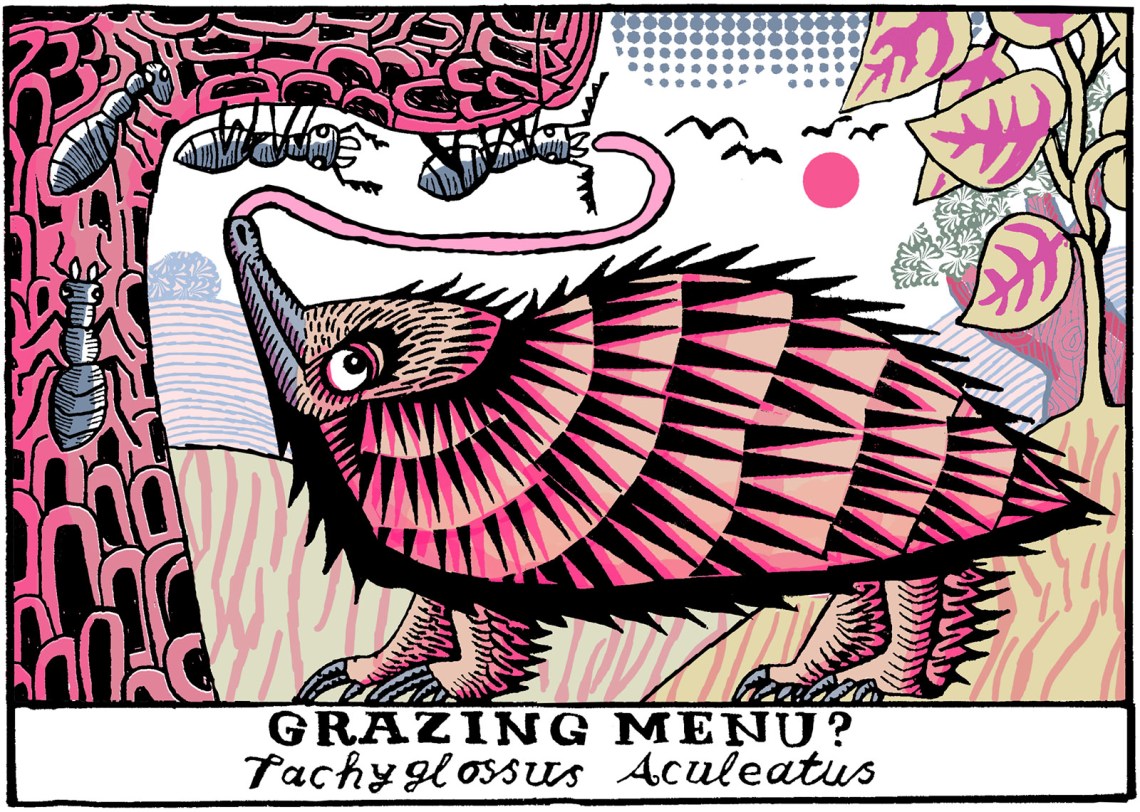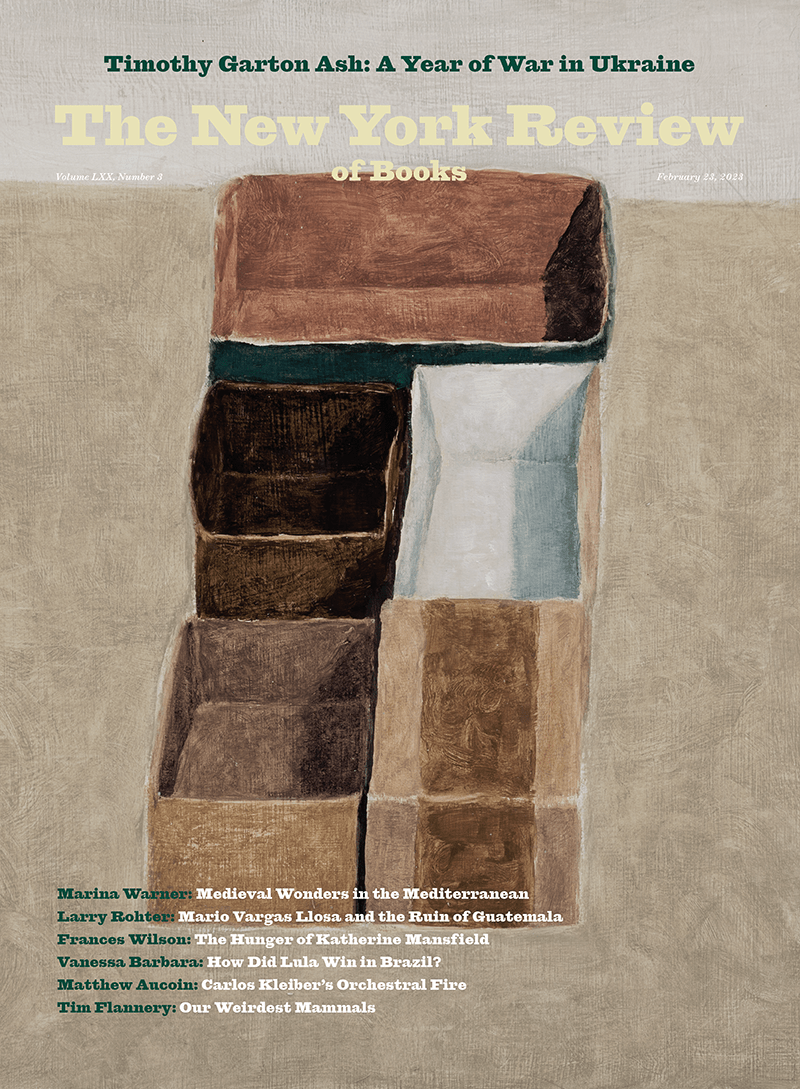Platypus Matters is Jack Ashby’s paean to a creature that he proclaims to be his favorite. Ashby, the assistant director of the University Museum of Zoology at the University of Cambridge, first became enamored of the platypus while examining a freeze-dried specimen held in the collections under his care. Freeze-drying leaves animals looking remarkably lifelike (unlike taxidermy, which can distort them), and the experience of handling such an exhibit left Ashby thirsting to see an actual, living platypus. So he traveled to Australia, and this charming, informative book is the result.
Platypuses, famously, are mammals that have ducklike bills and lay eggs. But there is far more to these anomalous animals than that. Although they rarely rate a mention among Australia’s venomous creatures, their toxin—delivered by a spur on their back ankles—is so deadly that it can kill a rabbit in just ninety seconds. And while a human fatality is yet to be recorded, the experience of being stung can be excruciating. Keith Payne, a recipient of the Victoria Cross (the nation’s highest military award), has said that being stung by a platypus was worse than being struck by shrapnel. Fifteen years later he was still experiencing stiffness and discomfort in the affected hand.
The platypus spur is almost an inch long and wickedly pointed and curved, resembling a much-thickened rattlesnake fang. The fact that only males have them suggests that they are used in combat with other males during territorial and reproductive disputes. Although females lack spurs, weigh only two pounds, and like all adult platypuses have no teeth, they can be tough customers, too. In 2019 a female platypus, who was possibly carrying eggs stuck to her tail, was captured on video as she killed a rakali—Australia’s carnivorous native water rat, which can weigh more than two pounds and has nasty stabbing incisors—after it attacked her. The battle lasted twenty minutes before the platypus finally managed to drown her assailant.
The food requirements of platypuses are prodigious. A lactating female can eat her own weight in worms, freshwater crayfish, and other invertebrates each day. Platypuses close off both their ears and their eyes when they dive, yet for almost two centuries scientists showed a remarkable lack of interest in how they find so much food. Only in 1986 did they discover that monotremes—the order of egg-laying mammals that includes platypuses and echidnas, and that today is found only in Australia and on New Guinea—possess a sense that other mammals almost entirely lack. Using specialized cells located in their bills, they can detect the electrical fields given off by all living things. The development and perfection of this novel and highly effective sense allows them to locate food even in dark and muddy water.
Ashby’s first sighting of a living platypus occurred in Tasmania’s wilderness, a World Heritage site, where he was fortunate enough to observe one from just five feet away. The experience was transformative and has drawn him back repeatedly to the Tasmanian highlands, even in the depths of winter, when the lakes are skinned with ice and the Roaring Forties blow rain and snow into his face. The fact that platypuses can survive in such frigid conditions is not surprising. A recent study suggests that the monotremes first arose 130 million years ago inside the south polar circle, at a time when Australia and Antarctica were joined. Indeed, it seems that their electrosensitive abilities developed as a means to help them find food during the dark and frigid three-month polar winter. Fossils of platypuses from 64 million years ago have been found in southern South America, so it is probably more accurate to think of them as Antarctic rather than Australian creatures.
The more one knows about platypuses, the more amazed one becomes. Their young, called puggles, break out of their leathery eggs with the help of an “egg tooth,” a feature also possessed by young birds. While the egg tooth is shed after a couple of days, the caruncle, a knob on the snout that also aids the young in hatching, remains for several months, during which puggles use it to stimulate the flow of milk from their mother’s body. Platypus milk is produced by mammary glands on the female’s chest, yet platypuses (and echidnas) lack nipples. This means that the young must slurp the milk from their mother’s fur. This can be a rather unsanitary practice, and to counter any potential ill effects, platypus milk is laced with antibacterial properties, which are currently under study for possible uses in medicine.
For decades after the platypus became known to Europeans, its means of reproduction was argued over by savants. Yet the truth was there all along if only the Europeans had asked Aboriginal people, who were familiar with how it was done. Instead, Europe’s best and brightest speculated on the basis of the few pickled or skinned specimens to reach the continent. During the nineteenth century Sir Richard Owen, the most famous anatomist of his day, believed that the platypus did not lay eggs but instead produced live young. He was perplexed by their nipple-less mammary glands, squeezing and prodding the chests of females whose bodies had lain for months if not years in preserving fluid. So determined was he to discover how the milk was expressed that he admitted to tasting the “drops of yellowish oil” that issued from tiny holes in the breast skin of a pickled female, though he could not detect any traces of milk.
Advertisement
The reproductive anatomy of male monotremes is as bizarre as that of the females. Echidna penises, which can be impressively large, have four heads, only two of which become erect at a time. Platypus and marsupial penises, incidentally, have two heads (being bifurcated toward the end), while placentals like us humans have simple, single-headed penises. Perhaps to the dismay of some, evolution in this instance seems more interested in function than exoticism.
The sprawled gait, relatively low body temperature, and egg laying (not to mention lack of nipples) of the monotremes have suggested to some that the platypus and the echidna are primitive mammals, an assertion that Ashby vigorously rejects. Indeed, he says that the entire premise of this assumption is flawed and “convenient for upholding the unscientific colonial philosophy that placental mammals like us are a cut above the beasts from down under”: any idea of an evolutionary ladder, in which one species is placed higher than another, is a fundamental misconception. All living species, he states, are adapted to their own environments, and none should be seen as more advanced than others.
The echidna illustrates just how wrongheaded is the idea that monotremes are primitive. These spiny egg-layers have brains that are deeply folded (as are human brains) and about as large relative to their bodies as that of a cat. What really sets the echidna brain apart, however, is its prefrontal cortex (the part of the brain used for planning and analysis)—that of the short-beaked is the largest of any mammal in proportion to overall body size. Could echidnas be the Einsteins of the animal world? It is difficult to know what is going on behind their tiny eyes and leathery, expressionless faces. But New Guinea’s long-beaked echidnas can be remarkably affable and interactive. These giants, which can grow up to a meter long and live for over half a century, appear to be able to recognize individual humans and remember them for years. Having encountered them in New Guinea’s forests as well as in zoos, I rate their intelligence as far above that of the average mammal.
The myth that Australian mammals are primitive remains widespread, perhaps in part because it has such deep roots in European Australian culture. The first Europeans to settle in Australia experienced feelings of fear, alienation, and displacement. Even though they lived around the magnificent Sydney Harbor, with its mild climate, bright sandy beaches, and glorious natural environment, they found the place a sort of hell. After a year’s residence, the Scots lieutenant governor Robert Ross wrote:
In the whole world there is not a worse country than what we have yet seen of this. All that is contiguous to us is so very barren and forbidding that it may with truth be said, here nature is reversed; and if not so, she is nearly worn out.
As the settlers discovered the land’s mammals, their horror only increased. Anomalies like the duck-billed platypus and the kangaroo, which grows its young in a pouch, were ranked along with the indigenous people (whom many characterized as “naked, black savages”) as monstrous and backward. As the first generation of Australian-born Europeans grew up—tall, barefoot, and entirely lacking European airs and graces—the fear arose that Australia could turn its inhabitants into primitives. Such beliefs long endured, and even my parents’ generation felt a distinct sense of cultural inferiority when visiting Britain.
About half of Platypus Matters is taken up with descriptions of the monotremes; much of the remainder is devoted to Australia’s remarkable marsupials. Who would have guessed that kangaroos have three vaginas (two for sex and one for giving birth), or that the male thylacine (along with all other marsupials) has its testicles in front of its penis? Then there is the honey possum, which weighs only a third of an ounce and feeds on banksias and other flowers in the southwest of the state of Western Australia. Nobody knows why this obscure creature has the longest sperm of any mammal—outdoing in length even those of the mighty blue whale. While the honey possum carries the laurel for sperm, the common wombat surely outdoes all in its ability to produce geometric feces: it is the only creature on earth that excretes cube-shaped fecal pellets. Not even its cousin the hairy-nosed wombat comes near it for sculptural excellence.
Advertisement
Some Australian marsupials live fast and spectacular lives. Male antechinuses, brown shrewlike animals common even around cities in southeastern Australia, indulge in a practice known as “suicidal reproduction” (or semelparity). This unfortunate condition is, according to Ashby, driven by the females, who all become receptive for a very brief period, during which males forgo all thoughts of feeding and resting and lead a competitive, orgiastic life, mating for up to fourteen hours per day with whichever female will have them. By the end of this rake’s progress, Ashby says, the males are “balding, covered in scabs, sores, ticks and other parasites, and are pretty darned disgusting.” The females, meanwhile, have had the benefit of intense sexual selection, mating with only the fittest males, and later they and their newborn young can consume all the food left behind by their recently departed sexual partners.
There’s a temptation for more than a few male Homo sapiens to search for a parable in all of this, but Ashby maintains a stiff upper lip and does not yield to it. Instead he turns his attention to banishing misconceptions about Australia’s wildlife. One is that marsupials are largely silent (the boar-like grunts of koalas and the frightening yowls of yellow-bellied gliders put that idea to rest). Another is that marsupials are not social. Well, try telling that to a rock ringtail possum as it stands guard over its group while they forage, or to the feathertail gliders that breastfeed one another’s young.
Ashby’s intoxication with Australia’s mammals makes for a marvelous read. While somewhat disorganized, Platypus Matters is full of astonishing facts that are certain to have you thinking differently about Australia’s unique mammalian fauna and on occasion questioning the wisdom of the evolutionary process.
Koalas have to be Australia’s most loved mammal, but not everyone agrees that they are cute. In 1983 John Brown, then Australia’s minister for tourism, revealed a nasty antikoala streak, saying:
The belief of Americans that they are a lovely, cuddly little bear is fairly well exploded when they get here and pick one of the rotten little things up. They find it’s flea-ridden, it piddles on you, it stinks and it scratches.
Igor Stravinsky was likewise not impressed, saying that the koala he held while visiting Taronga Zoo in Sydney in 1961 had the face of a banker. For many, however, koalas resemble infant humans, being similar in size and very roughly in shape. They fit nicely into the crook of one’s arm, and the most tractable seem to enjoy being cradled by a human.
Without doubt one of koalas’ most endearing characteristics is their inclination to seek help from people. They do so by turning their cute faces toward us and giving a seemingly imploring look while reaching with their arms, much like a child who wants to be picked up. During Australia’s catastrophic 2020 bushfires, images of koalas being helped by people were constantly in the media. Yet they may simply see us as tall objects worth climbing. As Danielle Clode writes in Koala, “Where they see a tree, we see an infant asking for help.”
Koalas are arguably Australia’s best-studied mammal. Their genome has been fully sequenced, and there have been more scientific papers written on them than on any other Australian mammal. Yet there remains much that we do not know. Famously, koalas eat the leaves of eucalyptus trees. Yet they are highly selective about what leaves they eat, and out of the eight hundred or so eucalyptus species and subspecies that grow in Australia, merely three to ten form the mainstay of any one koala’s diet. You’d have to ask a koala to find out why some leaves are preferred over others.
Clode, a science writer, is fortunate to live in a corner of Australia where koalas are thriving. In the Adelaide Hills, near her home in the state of South Australia, four or five koalas can often be seen in a single tree, and the population density is estimated at 540 individuals per square mile. The numbers continue to expand, and koalas can now be seen in the parklands that ring the city of Adelaide itself. Why, Clode asks, do koalas abound across the south of the continent (in South Australia and Victoria) yet are increasingly endangered in the east (in Queensland and New South Wales)?
One clue lies in the fact that many of the southern koala populations (including that in the Adelaide Hills) originated in translocations by humans, while the eastern ones were greatly reduced by hunting. In 1919 koalas so abounded in Queensland that between April and September, around a million were killed for their skins. (Nevertheless, they remained abundant throughout the decade: 600,000 were killed in August 1927 alone.) It’s uncertain whether koalas inhabited the Adelaide Hills at the time of initial European settlement. Certainly by the 1920s any original koalas there had been exterminated. The current population in South Australia seems to have come in part from Kangaroo Island (whose population had originated in Victoria). This shows in its limited genetic diversity. But that hasn’t stopped its members from flourishing.
As Clode documents, koalas are all but absent from Aboriginal oral history, material culture, art, and archaeological deposits, which suggests that they were uncommon before European colonization. They remained rare and restricted in distribution during the early colonial period. Sydney was settled by Europeans in 1788, but koalas remained unknown to them until 1798. Other early explorers encountered them only in the densest forests.
How then to account for their extraordinary abundance in places like Queensland a century ago, and in the Adelaide Hills today? I suspect that if koalas are protected from hunting, their populations can build up rapidly. But then other factors, such as starvation and diseases like chlamydia, can reduce their populations. Genetic studies suggest that some strains of chlamydia are endemic in koala populations. New strains that originated in sheep and cattle can also infect koalas. Diseased individuals can be a dreadful sight—blind, sterile, and suffering chronic bladder infections that cause them to cry in pain whenever they urinate. Many humans feel compelled to help, and victims are nursed back to some semblance of health in koala hospitals. A chlamydia vaccine is even under development. Despite all this, today the threats to koalas are multiplied, especially in areas of high human population density. They are attacked by dogs and hit by vehicles on highways, and their forests are cut down for housing developments, isolating populations that are too small to be genetically viable.
Many Australians, including Clode, would like to see a large, stable population of koalas in suitable habitats across the continent. But what if they really are a boom-and-bust species (like lemmings and locusts), whose numbers can grow quickly but then crash in a Malthusian disaster as disease and starvation spread? Such outcomes are so appalling to some humans that they have intervened where overpopulation of koalas threatens starvation. Measures have included relocation and various forms of sterilization (including castration), but it’s difficult to catch and operate on all koalas, so these methods struggle to control population growth.
Paradoxically, the childlike appeal of the koala may be the foremost impediment to its effective conservation. It compels us to help individuals, yet in doing so we sometimes lose sight of the health of the species as a whole. Despite this tendency, there are indications of how we can help. The healthiest populations have all resulted from the translocation of individuals into new habitats that previously lacked koalas. Perhaps the most important part that humans will have in protecting them is to continue moving them around the country.




